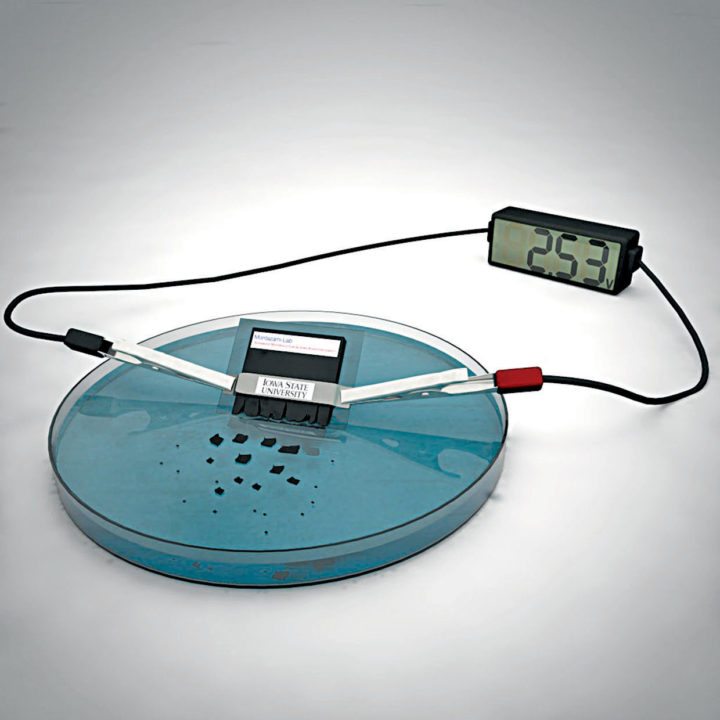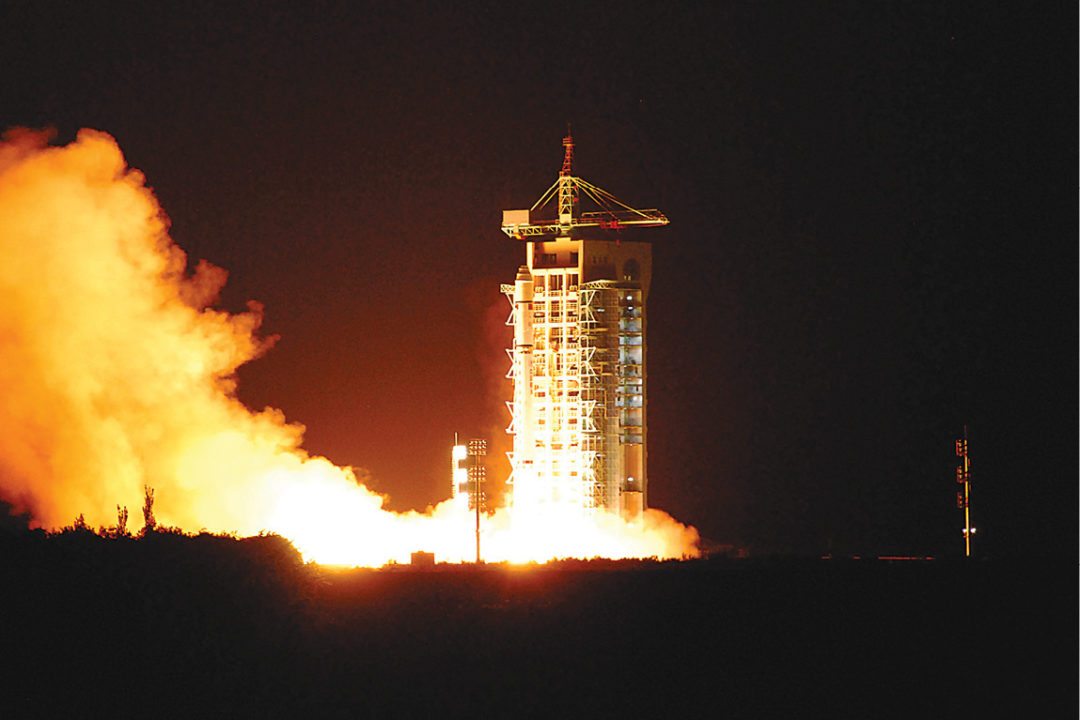Battery that self-destructs in 30 minutes
Iowa State University, USA, scientists have developed a self-destructing battery that can power a simple electronic device such as a four-function calculator for up to 15 minutes and then dissolve in water. This could pave the way for so-called transient power sources for scientific instruments or tools of espionage.

This new battery represents a marked improvement in voltage and disintegration time over its predecessors, according to the researchers. The battery’s polymer casing is made from a molecule that can form long repeating chains, swell and physically break itself and other components into small pieces when exposed to water. Devices powered by this type of battery could serve their function or transmit data and then be washed away in the rain.The battery can generate about 2.7 volts, which is similar to the electric potential produced by a pair of conventional AA batteries. This means the new invention can power devices that lower-voltage transient batteries cannot. However, use of lithium makes it unsuitable for biomedical applications such as power implants.
Machine learning to help eradicate world poverty
Scientists at Stanford University, USA, have found a low-cost method to map poverty in areas previously devoid of data, by combining satellite images and making use of machine learning. These improved poverty maps could help organisations and policymakers distribute funds more efficiently and evaluate policies.
One big challenge in providing relief to people living in poverty is locating them. Availability of accurate and reliable information on the location of impoverished zones is surprisingly lacking for much of the world, particularly in African countries. Aid groups and other international organisations often fill in the gaps with door-to-door surveys, but these can be expensive and time-consuming to conduct.
Researchers at Stanford University have used machine learning, which is the science of designing computer algorithms that learn from data, to extract information about poverty from high-resolution satellite imagery.
The team built on earlier machine learning methods to find impoverished areas across five African countries—Nigeria, Tanzania, Uganda, Malawi and Rwanda. Because areas that are brighter at night are usually more developed, the solution involves combining high-resolution daytime imagery with images of Earth at night.
China tests viability of quantum technology for secure communications
China has launched QUESS satellite that will test for the first time the viability of quantum technology for secure communications over long distances.

The 1.65kg Galassia nano-satellite, built by researchers at National University of Singapore (NUS), Singapore, carried a science payload of the size of a shoe box containing the basic components used in quantum communication and computing. Galassia was one of the six Singapore satellites that were launched by India’s Polar Satellite Launch Vehicle in December 2015.
The compact device, dubbed Small Photon-Entangling Quantum System (SPEQS), contains a laser diode, crystals, mirrors and photon detectors. It creates pairs of light particles called photons and measures the pairs’ properties—all on board the satellite.
According to the university website, analysis of data from the satellite “shows that SPEQS is making pairs of photons with correlated properties,” which is an indication that the device is performing as expected in orbit.
Temporary tattoos to control connected devices
Massachusetts Institute of Technology (MIT), USA, in partnership with Microsoft, has created a new touch interface, DuoSkin, which allows temporary tattoos to interact with smartphones or computers, display output based on body temperature changes and even transmit data using near filed communication.

Cindy Hsin-Liu Kao, PhD student at MIT and creator of DuoSkin, says that the tattoos are not only trendy, but cheap enough “to change and edit your appearance whenever you want.” She adds that in Taiwan there is a huge culture of intermingled cosmetics and street fashion. DuoSkin team wanted to achieve the same thing by keeping the technology affordable, attractive and on trend.
DuoSkin temporary tattoos can be made at home and washed off in a day. These use electrodes present in inexpensive gold leaves to create a conductive surface. The gold leaf and a thin layer of silicone adhere to the body to create an interface on the skin that when touched can convey certain commands to your electronic devices.
Researchers have developed three different types of tattoos. The first acts as a touchpad to control a computer cursor or adjust a music player. The second uses thermochromic pigments that change colour when body temperature rises. And, the third uses near field communication technology to transmit data such as photos between your phone and the tattoo.
Transparent gaming controller that acts like a second skin

Scientists at Seoul National University, South Korea, have created a stretchy, skin-like controller, which promises to turn a forearm into a touchpad for gaming, playing music and scrawling notes that appear on a computer screen. The team, led by researcher Chong-Chan Kim, along with Jeong-Yun Sun, a professor of materials science and engineering, imagines a future where we ditch brittle electrodes for soft, biocompatible technology.
The team developed the panel using a hydrogel made from polyacrylamide, which is a water-soluble acrylic resin, and lithium chloride salts that act like a conductor. Electrodes on both ends of the panel create a uniform electrostatic field. Pressing on it closes the circuit, allowing the current to flow to the touch point. Current meters at each corner pick up the signals and transmit these to a separate controller board that connects to a computer.
World’s first robot therapist helps relieve muscle strains

A Singapore based company, AiTreat, has developed a robot that can perform physiotherapy massages for muscle strains and injuries. Expert Manipulative Massage Automation, or EMMA, a robotic arm with a 3D-printed massage tip, can deliver massage therapy for sports injuries and muscular pains.
EMMA is designed as a clinically precise tool to carry out treatment automatically as per a physiotherapist’s prescription. It brings scientific data with a user-friendly interference and guidelines for pain management. It also helps medical practitioners carry out research and scientifically demonstrate to the patients the progress in treatment.
The robot has a single robotic arm that performs highly-articulate movements, a 3D stereoscopic camera for vision and a customised fully-rotatable 3D-printed massage tip. EMMA is also equipped with built-in pressure sensors to ensure safety and comfort of patients when performing pedal exercises.
Transparent circuitry to power smart windows
Scientists at King Abdullah University of Science & Technology (KAUST), Saudi Arabai, have found a way to make transparent transistors and other essential components of electronic circuitry, an advance that may lead to displays on car windscreens, transparent television sets and smartwindows.

Indium tin oxide (ITO) is the current material of choice for electronics because it combines optical transparency with electrical conductivity. Its use ranges from touch-sensitive smartphone screens to light-harvesting solar panels. Indium is in short supply, and as demand increases for ITO-containing devices, so does the price of indium.
A low-cost ITO alternative is a transparent material known as aluminium-doped zinc oxide (AZO).
Researchers have used a high-precision technology called atomic layer deposition, a process in which the circuitry is built with a single layer of atoms at a time. Volatile vapours of aluminium and zinc in the form of trimethyl-aluminium and diethyl-zinc are alternately introduced onto the transparent substrate, where these adhere to the surface in
a single layer before reacting in situ to form AZO.
Mind-reading car on road
Softbank founder Masayoshi Son has announced at an event in Tokyo that he is working with auto-giant Honda to come up with a car that can both talk and gauge human emotions.
Just like the talking car in the vintage series Knight Rider, the technology being developed will allow a vehicle to process natural language through cameras and in-car sensors, along with assessing the driver’s emotions and engaging in friendly banter, in addition to offering assistance.
If such a level of interactivity is achieved, it could help in parking or keeping the driver engaged during long trips, as well as take over control when the driver is sleepy or not in senses.
Softbank’s Pepper robot, recently powered by IBM’s Watson AI, may have a role to play in this as well, Son added.







